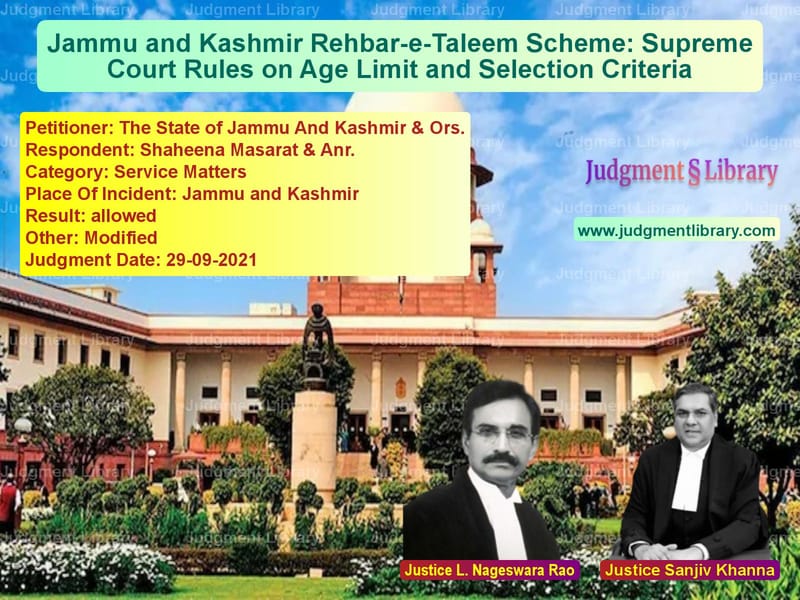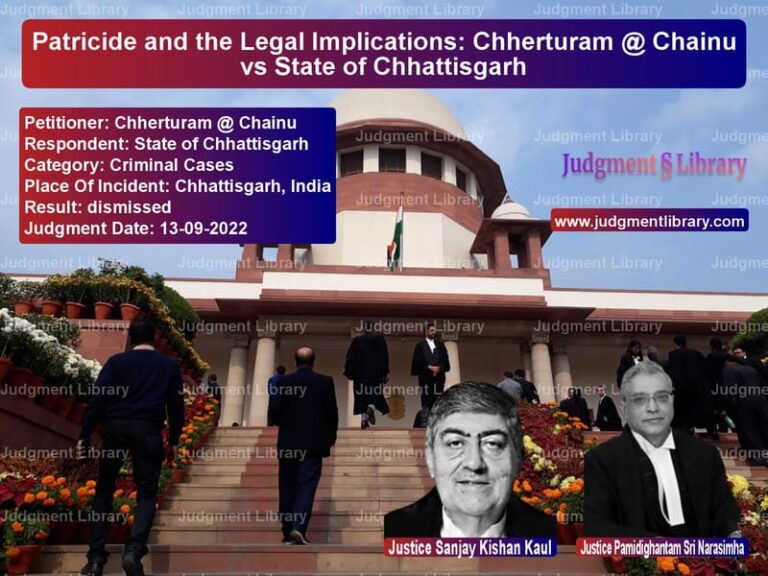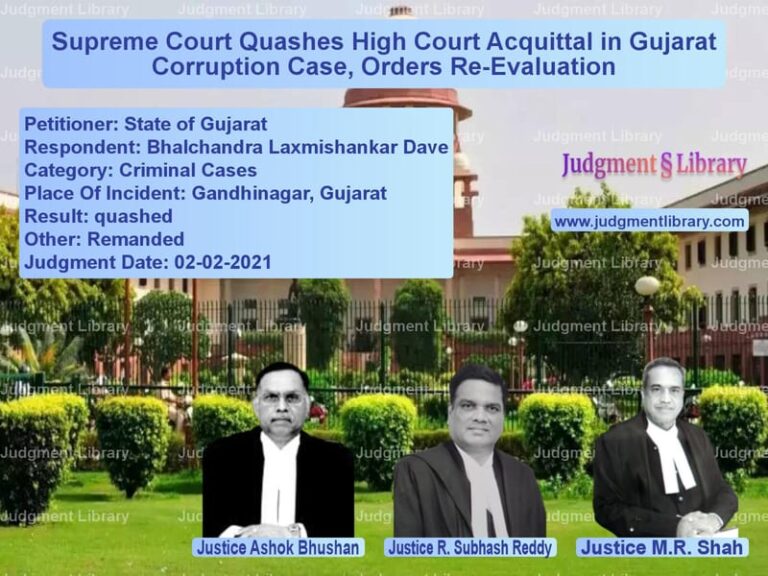Jammu and Kashmir Rehbar-e-Taleem Scheme: Supreme Court Rules on Age Limit and Selection Criteria
The Supreme Court of India, in the case of The State of Jammu and Kashmir & Ors. vs. Shaheena Masarat & Anr., addressed key issues related to the Rehbar-e-Taleem (Re-T) scheme, particularly concerning eligibility criteria, upper age limit, and arbitrary selection practices. This judgment highlights the importance of uniformity in public appointments and prevents the discretionary relaxation of age limits by authorities.
Background of the Case
The Rehbar-e-Taleem (Re-T) scheme was introduced by the State of Jammu and Kashmir on 28.04.2000 to decentralize elementary education management and promote community participation. The scheme aimed to fill staff deficiencies in primary and middle schools by appointing teaching guides (Re-Ts).
According to the scheme:
- Re-T appointments were to be made at the village level based on staff shortages.
- Applicants had to be permanent residents of the State and belong to the same village where the vacancy existed.
- The minimum qualification required was 10+2.
- Age criteria: The applicant should “as far as possible” fulfill the maximum age qualification as prescribed by the State.
The dispute in this case arose from the selection process conducted for the primary school at Bundook Khar Mohalla, Rainawari, under an advertisement dated 29.11.2002. Respondent No. 2 was selected for the Re-T position, which was challenged by Respondent No. 1, leading to the present legal battle.
Legal Dispute and Arguments
Petitioner’s (State of Jammu and Kashmir) Arguments
The State of Jammu and Kashmir contended that the High Court erred in its decision by:
- Directing the appointment of Respondent No. 1 while also continuing Respondent No. 2 in service.
- Overruling the decision of the Single Judge, which had found Respondent No. 2 eligible for appointment.
Respondent No. 1’s (Shaheena Masarat’s) Arguments
Shaheena Masarat argued that:
- Respondent No. 2 was ineligible as she had exceeded the maximum age limit of 35 years at the time of application.
- The relaxation of the age limit under SRO 30 of 2003 (which provided an additional 2 years) did not apply to this selection process.
- The Single Judge’s misinterpretation of the age relaxation criteria led to an erroneous dismissal of her writ petition.
Respondent No. 2’s Arguments
Respondent No. 2 defended her appointment, asserting that:
- Her selection complied with the advertisement criteria.
- The SRO 30 of 2003 age relaxation rule applied to all selections, making her appointment valid.
- Since her appointment in 2003, she had been serving continuously, and disrupting her employment now would be unjust.
Supreme Court’s Key Findings
1. Age Limit is Mandatory, Not Discretionary
The Supreme Court clarified that:
“The upper age limit notified in the advertisement was 35 years as of 01.01.2002. Respondent No. 2, having been born on 28.12.1965, was already above this limit.”
Thus, the Court ruled that she was ineligible for appointment.
2. SRO 30 of 2003 Does Not Apply Retroactively
The Court noted that:
“SRO 30 of 2003 gave an age relaxation from 01.01.2003 to 31.12.2004. However, the selection process had already commenced with the advertisement dated 29.11.2002. Therefore, SRO 30 cannot be applied retrospectively.”
3. Interpretation of “As Far As Possible”
The phrase “as far as possible” in the advertisement was central to the dispute. The Supreme Court agreed with the High Court’s ruling:
“Appointments to public posts must be strictly in accordance with Articles 14 and 16 of the Constitution of India. Eligibility criteria should be uniform. Allowing discretionary relaxation of age limits would lead to arbitrary selections.”
4. Respondent No. 1’s Appointment Was Justified
Since Respondent No. 1 fulfilled all eligibility criteria, the Court upheld the High Court’s direction to appoint her as an Re-T teacher.
5. Continuance of Respondent No. 2
The High Court had ordered that Respondent No. 2 be allowed to continue in service despite being ineligible. The Supreme Court found this incorrect and stated:
“There was only one post available. Having ruled that Respondent No. 1 was the rightful candidate, the High Court erred in allowing Respondent No. 2 to continue.”
Final Judgment
The Supreme Court ruled that:
- Respondent No. 1 should be appointed as Re-T.
- Respondent No. 2’s appointment was invalid, but since she had been in service since 2003, she should be accommodated in another vacancy.
- Respondent No. 2 would not be entitled to any benefits prior to her fresh appointment, except for the salary and allowances already paid.
Significance of the Judgment
This ruling has critical implications for recruitment and employment policies:
1. Preventing Arbitrary Selection
The Court’s ruling ensures that eligibility criteria are applied consistently, preventing favoritism or ad-hoc decisions by authorities.
2. Maintaining Transparency in Public Appointments
The judgment reinforces the principle that all candidates must be treated equally, and authorities cannot selectively relax age limits.
3. Fairness in Government Employment
The Court balanced the need for fairness by allowing Respondent No. 2 to be accommodated in another vacancy without disrupting her life completely.
Conclusion
The Supreme Court’s judgment in The State of Jammu and Kashmir & Ors. vs. Shaheena Masarat & Anr. upholds the fundamental principles of fairness, transparency, and uniformity in government recruitment. It clarifies that:
- Age limits for appointments must be strictly followed.
- Government orders granting relaxations do not apply retroactively.
- Discretionary relaxations of eligibility criteria can lead to unconstitutional practices.
This decision serves as an important precedent in cases concerning public employment and recruitment policies, ensuring that merit-based selections remain fair and just for all applicants.
Petitioner Name: The State of Jammu And Kashmir & Ors..Respondent Name: Shaheena Masarat & Anr..Judgment By: Justice L. Nageswara Rao, Justice Sanjiv Khanna.Place Of Incident: Jammu and Kashmir.Judgment Date: 29-09-2021.
Don’t miss out on the full details! Download the complete judgment in PDF format below and gain valuable insights instantly!
Download Judgment: the-state-of-jammu-a-vs-shaheena-masarat-&-a-supreme-court-of-india-judgment-dated-29-09-2021.pdf
Directly Download Judgment: Directly download this Judgment
See all petitions in Employment Disputes
See all petitions in Recruitment Policies
See all petitions in Public Sector Employees
See all petitions in Termination Cases
See all petitions in Judgment by L. Nageswara Rao
See all petitions in Judgment by Sanjiv Khanna
See all petitions in allowed
See all petitions in Modified
See all petitions in supreme court of India judgments September 2021
See all petitions in 2021 judgments
See all posts in Service Matters Category
See all allowed petitions in Service Matters Category
See all Dismissed petitions in Service Matters Category
See all partially allowed petitions in Service Matters Category







